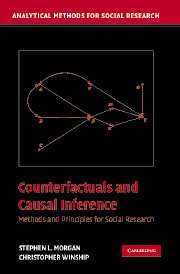Book contents
- Frontmatter
- Contents
- Acknowledgments
- Part 1 Counterfactual Causality and Empirical Research in the Social Sciences
- Part 2 Estimating Causal Effects by Conditioning
- 3 Causal Graphs, Identification, and Models of Causal Exposure
- 4 Matching Estimators of Causal Effects
- 5 Regression Estimators of Causal Effects
- Part 3 Estimating Causal Effects When Simple Conditioning Is Ineffective
- Part 4 Conclusions
- References
- Index
5 - Regression Estimators of Causal Effects
Published online by Cambridge University Press: 05 June 2012
- Frontmatter
- Contents
- Acknowledgments
- Part 1 Counterfactual Causality and Empirical Research in the Social Sciences
- Part 2 Estimating Causal Effects by Conditioning
- 3 Causal Graphs, Identification, and Models of Causal Exposure
- 4 Matching Estimators of Causal Effects
- 5 Regression Estimators of Causal Effects
- Part 3 Estimating Causal Effects When Simple Conditioning Is Ineffective
- Part 4 Conclusions
- References
- Index
Summary
Regression models are perhaps the most common form of data analysis used to evaluate alternative explanations for outcomes of interest to quantitatively oriented social scientists. In the past 40 years, a remarkable variety of regression models have been developed by statisticians. Accordingly, most major data analysis software packages allow for regression estimation of the relationships between interval and categorical variables, in cross sections and longitudinal panels, and in nested and multilevel patterns. In this chapter, however, we restrict our attention to OLS regression, focusing mostly on the regression of an interval-scaled variable on a binary causal variable. As we will show, the issues are complicated enough for these models. And it is our knowledge of how least squares models work that allows us to explain the complexity.
In this chapter, we present least squares regression from three different perspectives: (1) regression as a descriptive modeling tool, (2) regression as a parametric adjustment technique for estimating causal effects, and (3) regression as a matching estimator of causal effects. We give more attention to the third of these three perspectives on regression than is customary in methodological texts because this perspective allows one to understand the others from a counterfactual perspective. At the end of the chapter, we will draw some of the connections between least squares regression and more general models, and we will discuss the estimation of causal effects for many-valued causes.
- Type
- Chapter
- Information
- Counterfactuals and Causal InferenceMethods and Principles for Social Research, pp. 123 - 166Publisher: Cambridge University PressPrint publication year: 2007

